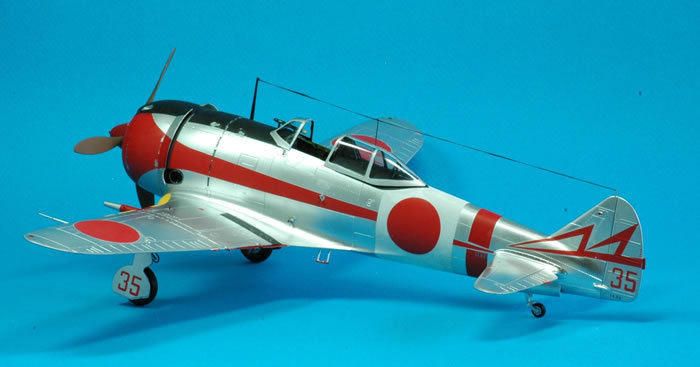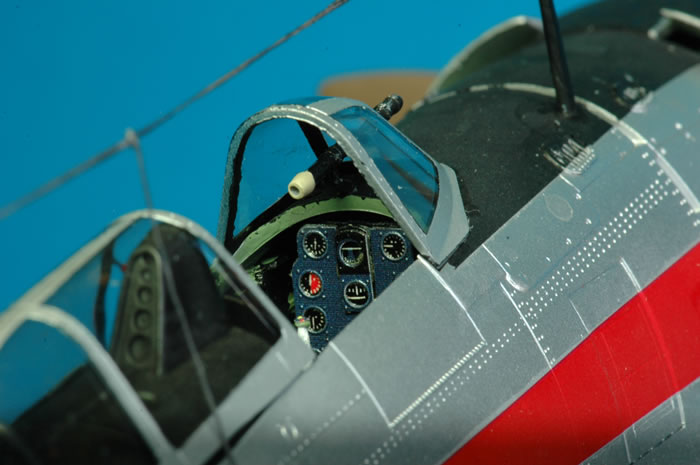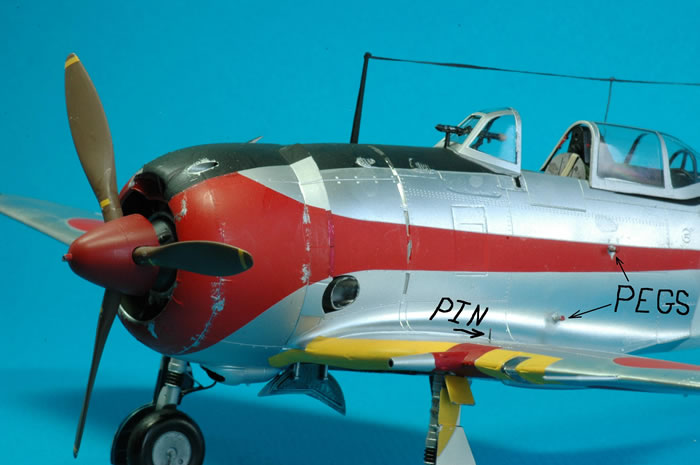Hasegawa's 1/32 scale
Nakajima Ki 44-II Otsu Shoki (Tojo) w/40mm Cannon
by Andrew Garcia
|

|
Nakajima Ki 44-II Otsu Shoki (Tojo) w/40mm Cannon |

Hasegawa's 1/32 scale Ki-44 is available online from Squadron.com
 The Ki-44 Shoki “Tojo” was the design platform for a home defense fighter. In 1938, Nakajima Aircraft of Japan received an order for a high speed air defense interceptor, that was known as the Imperial Army Type 2 Fighter, also called the Ki-44, almost simultaneously with an order for the Ki-43 Oscar. High speed and better climb rate were favored at the sacrifice of maneuverability. These requirements were met through the use of Japan's most powerful engine at the time, the HA-41 which was originally intended for bomber use. The Ki-44 Shoki “Tojo” was the design platform for a home defense fighter. In 1938, Nakajima Aircraft of Japan received an order for a high speed air defense interceptor, that was known as the Imperial Army Type 2 Fighter, also called the Ki-44, almost simultaneously with an order for the Ki-43 Oscar. High speed and better climb rate were favored at the sacrifice of maneuverability. These requirements were met through the use of Japan's most powerful engine at the time, the HA-41 which was originally intended for bomber use.
Tei Koyama had the chief responsibility for designing the Ki-44. He accepted the visibility restrictions creating an aircraft that was smaller than either the Ki.27 Nate or Ki.43 Oscar creating a small, thinly tapered fuselage with a large frontal surface. A two way radio and drop tank was also incorporated into his design. The Ki-44 featured Nakajima designed "butterfly" combat flaps (Fowler Flaps) to improve maneuverability. This greatly improved its ability to maneuver in combat as well as reduce landing roll and take off distance. It did however also have poor visibility at takeoff and landing due to the large cowling. Many pilots transitioning from the Ki-27 Nate realized this in addition to its instability during low speed flight. However, in a comparison test program it beat the Bf-109 and Ki-60 (forerunner of the Ki-61) in a series of trials. The Imperial Japanese Army adopted it in 1942 as the Type 2 Single Seat Fighter. During a comparison with the IJN Zero-sen the Tojo was found to climb to interception altitudes better than the Zero but despite a larger engine was not significantly faster.

It was nicknamed Shoki (Demon) and code named "Tojo" by the Allies. The type 2 Model II carried a more powerful engine, the HA-109, with its two-stage supercharger. There were three versions, the Koh, Otsu and Hei distinguished by visible external changes. A total of 1,227 Ki-44's were built between 1940 and 1944. For the new to the Ki-44 modelers like me this kit, the Ki-44-II Otsu release from Hasegawa in 1/32nd scale (# 08200), is for the second version of the Shoki. The two main characteristics that indicate which version you have are:
Ki-44-I has a telescopic gunsight which protrudes through the front windscreen in the initial version. Later versions used a reflector gunsight. The oil cooler was initially found in a copper ring inside the front of the engine cowl similar to the Ki-27. The second version, Ki-44 II, which is also the version provided with this kit (#8200), has a reflector gunsight and an external oil cooler (this change started with KI-44 serial # 1054) on the lower engine cowling. Initial armament was comprised of two 7.7mm (.30 cal) cowl guns and two 12.7mm (.50 cal) wing mounted guns. A few were armed with a pair of 40mm wing guns, and the cowl guns used the 12.7mm guns with the 12.7mm guns in the wings late in the war in the Ki-44-IIb variant. This bomber buster was made in the units with serial numbers 1356 to 1749. The 40mm guns, utilizing novel caseless rocket propulsion for the bullet was a disappointment due to low muzzle velocity. Thus, the armament was changed in later versions to four 12.7mm guns starting with airframe number # 1750 with two 12.7mm (.50 cal) cowl guns and two 12.7mm (.50 cal) wing mounted guns. Some early Ki-44-IIc units were equipped with the telescopic gunsight so as always it is best to model your kit using photo reference.
The 40mm equipped Shoki’s never really proved of value during the Philippines campaign. Most of them were destroyed on the ground. When Clark airfield was overrun some examples were captured giving us a good photo opportunity using TAIU photographers to clearly photograph on February 14, 1945, a Ki-44-IIb serial number 1747 and a Ki-44-IIc, serial number 2068 for posterity. TAUI numbered the captured aircraft serial number 2068 as “S-11” which was an aircraft from the last production run. By then the decision to stop Ki-44 production, it was by then a five year old design, for the newer Ki-84, was the order of the day.
Nakajima only assembled two major models of the Ki-44, the Ki-44-I and the Ki-44-II. Errors were made in categorizing the Ki-44-II in many publications because the time honored tradition of later models having the large or heavier weapons. However, this did not occur with Shoki production. A final prototype, the Ki-44-III was built but never progressed due to the war’s end. Some Ki-44’s soldiered on for the Nationalist Chinese Army in Nanking and also by the communist forces as part of the Red Army of China. None were reported used in combat but some photos exist. No news of the final disposition of those aircraft has surfaced yet.
Hasegawa released kit # 08200, the Ki44-II Otsu SHOKI (TOJO) w/40mm CANNON in December 2009. It is a well moulded kit with very fine details. I usually build in 1/48th scale and have built several Hasegawa Ki-44 kits in 1/48th so I was looking forward to this kit. There is a minimal parts count and it goes together rather quickly unless you want to take some time to detail the cockpit interior. Even then, the cockpit is sparse and detailing it did not take very long primarily due to my use of an Eduard "BIG ED" detailing set providing painted etched metal parts for the cockpit and unpainted detailing items for the rest of the airframe, inside and out. Due to the diminutive size of the actual aircraft it is not overly large in 1/32nd scale.

Markings are provided for two natural metal finish (NMF) aircraft, one from the 1st Chutai, the second from the 2nd Chutai, both part of the 47th Hiko Sentai at Narimatsu Airfield, Japan. These were much more colorful than the versions found at Clark Airfield in the Philippines since they incorporate the white homeland defense ID bands with the hinomarus. The color box art also supplements the painting information in the kits building instructions. I honestly had a problem selecting which color scheme to use. Both versions are quite attractive and colorful. I opted for the box art version, construction number (C/N) 1435, the markings for the 2nd Chutai aircraft.

For the pilot entry pegs I drilled a hole and glued in a metal straight pin. I then cut off the front of the Eduard etched peg part # 24 and slipped on the square perforated peg/step onto the glued in pin. The cut off part was glued on to the end to represent the red painted cap found on the entry step. The next step was to attach the landing gear status pins on the wings and paint them. They are similar to those found on the Fw-190 and usually missing on most Ki-44 builds. Once you look for and see this part on historical period photos of the Ki-44 it makes sense to put them on the aircraft. While they were not an implicit part of the Eduard Big Ed etched parts nor found in its instructions, I did use two pieces of unused etched from the etched metal sheet for these parts.

I inserted a metal pin at the top of the vertical stabilizer to represent a small antenna tail mast because this is missing from the kit plastic. I used E-Z-Line for the antenna wire. The point of insertion for the drop down antenna wire into the fuselage, on the starboard side of the airframe, has a well moulded plastic extension which was used to glue on the drop down portion of the antenna wire. I attached the exhausts after the cowl was painted and avoided repainting them. Testors exhaust metalizer was used on the exhausts. I could do this out of sequence because Hasegawa provided a keyed attachment point for the exhaust to the fuselage mating.
This kit went out of production (OOP) in 2011, unfortunately, and is becoming more difficult to find although there are still some out there on local hobby shop shelves including frequent appearances on eBay. Given there are usually two 1/32nd scale Ki-44 releases available at all times from Hasegawa, an alternative of using the Wolfpack Designs resin 40mm guns permits you convert the available kits into the 40mm version since all the other parts are there to build this version.
The Hasegawa 40mm Shoki kit is a gem. I saw one built and displayed at a model show and knew I had to have one even though I am not a 1/32nd scale builder. The current releases of 1/32nd scale kits are fantastic but due to the room it takes to store and display 1/32nd scale models I have avoided them for the most part (i.e. except for the 1/32nd Tamiya Mustang and Corsair). The overall shape and dimensions of the kit are perfect and you can build a very nice model from this kit with minimal application of modeling skills. I encourage you to build one as a break from AMS since no aftermarket is required for a nice outcome. If you want additional detail as I did, the Eduard set fits in and provides some easy to work with enhancements.
Images and Text Copyright ©
2013 by Andrew Garcia
Page Created 27 August, 2013
Last Updated
27 August, 2013
Back to
HyperScale Main Page

|
Home
| What's New |
Features |
Gallery |
Reviews |
Reference |
Forum |
Search